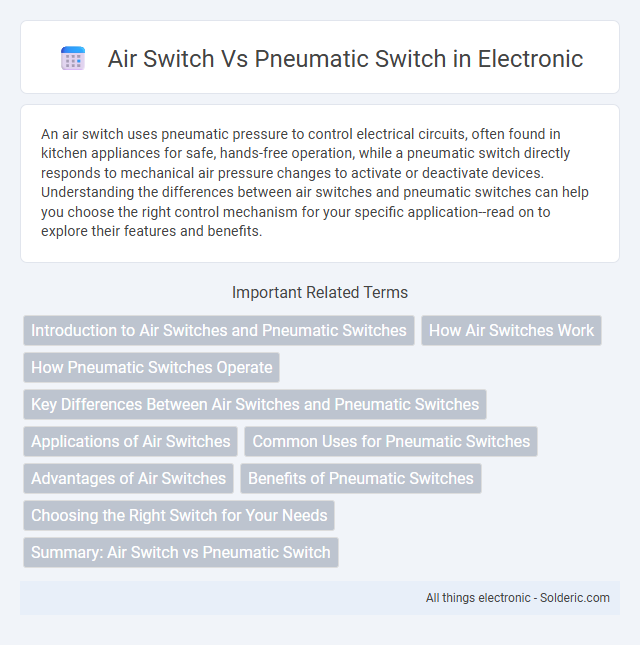An air switch uses pneumatic pressure to control electrical circuits, often found in kitchen appliances for safe, hands-free operation, while a pneumatic switch directly responds to mechanical air pressure changes to activate or deactivate devices. Understanding the differences between air switches and pneumatic switches can help you choose the right control mechanism for your specific application--read on to explore their features and benefits.
Comparison Table
| Feature | Air Switch | Pneumatic Switch |
|---|---|---|
| Definition | Switch activated by changes in air pressure or flow | Switch operated using compressed air as the control medium |
| Operation | Triggers with minimal air pressure variations, sensing airflow | Requires continuous compressed air supply to actuate switch mechanism |
| Applications | Used in ventilation systems, HVAC controls, and airflow monitoring | Common in industrial pneumatic systems, machinery controls, and automation |
| Sensitivity | Highly sensitive to subtle air pressure changes | Dependent on regulated pneumatic pressure levels for reliable operation |
| Installation | Simple; connects easily to air ducts or tubing | More complex; integrates with pneumatic lines and requires air compressor setup |
| Cost | Generally lower due to simpler design and no compressor needed | Higher costs due to equipment and maintenance of compressed air systems |
| Reliability | Reliable in monitoring airflow but limited by environmental contamination | Robust and durable in industrial environments with proper maintenance |
Introduction to Air Switches and Pneumatic Switches
Air switches use compressed air to activate electronic devices, offering a reliable, moisture-resistant control mechanism ideal for wet environments such as kitchens and bathrooms. Pneumatic switches operate through air pressure changes within a sealed system to trigger electrical circuits, commonly used in industrial machinery and safety applications where mechanical isolation is crucial. Both switches provide contactless operation, reducing wear and increasing device longevity compared to traditional mechanical switches.
How Air Switches Work
Air switches operate by using compressed air to transmit a signal from a remote activation point to a controlling device, typically found in kitchen sinks or garbage disposals. When you press the button, it sends a burst of air through a small tube, triggering the switch mechanism without requiring electrical contact at the activation site. This design enhances safety by isolating the electrical circuit from moisture and allowing easy installation in wet environments.
How Pneumatic Switches Operate
Pneumatic switches operate by using air pressure to activate electrical contacts, converting mechanical force into a signal without direct electrical contact. When air pressure is applied to the switch's diaphragm or piston, it moves to open or close the circuit, providing safe, reliable control in hazardous or wet environments. Your system benefits from improved durability and resistance to moisture or explosive atmospheres through this non-electrical actuation method.
Key Differences Between Air Switches and Pneumatic Switches
Air switches operate by using a burst of air pressure transmitted through a tube to activate an electrical switch, making them ideal for wet or hazardous environments without direct electrical contact. Pneumatic switches rely on mechanical movement caused by air pressure changes within a system to trigger switching functions, often found in industrial automation and control applications. Understanding these differences helps you select the right switch for safety, reliability, and application-specific needs.
Applications of Air Switches
Air switches are commonly used in hazardous environments where electrical sparks must be avoided, such as in chemical plants, gas stations, and paint booths. Their ability to operate pneumatic controls without direct electrical contact makes them ideal for controlling pumps, compressors, and industrial machinery. These switches are also favored in medical and laboratory equipment for their reliability and safety in sterile or explosive atmospheres.
Common Uses for Pneumatic Switches
Pneumatic switches are commonly used in industrial automation, HVAC systems, and machinery control due to their reliability in environments with high moisture, dust, or explosive gases. These switches operate through air pressure changes to trigger electrical circuits, making them ideal for hazardous areas where electrical sparks must be minimized. Their ability to function without direct electrical contact enhances safety and durability in demanding applications such as manufacturing plants and pneumatic tools.
Advantages of Air Switches
Air switches offer enhanced safety by isolating electrical components from moisture and direct contact, reducing the risk of electrical shock. Their simple mechanical operation ensures reliability and longevity, making them ideal for wet environments like kitchens or bathrooms. You benefit from their quiet, maintenance-free performance and ease of installation compared to pneumatic switches.
Benefits of Pneumatic Switches
Pneumatic switches provide enhanced durability and reliability in harsh environments due to their resistance to moisture, dust, and vibration, making them ideal for industrial applications. They operate without electrical contacts, reducing the risk of sparks and improving safety in explosive or flammable atmospheres. Maintenance requirements are minimal, ensuring longer service life and reduced operational downtime compared to air switches.
Choosing the Right Switch for Your Needs
Selecting the right switch depends on the specific application requirements such as pressure sensitivity, durability, and environmental conditions. Air switches offer reliable operation in wet or hazardous environments due to their sealed pneumatic design, while pneumatic switches excel in high-pressure industrial settings requiring precise control and fast response times. Evaluating factors like installation complexity, maintenance needs, and operational safety will guide the choice between an air switch and a pneumatic switch for optimal performance.
Summary: Air Switch vs Pneumatic Switch
An air switch uses a low-voltage electrical signal activated by air pressure, commonly found in kitchen garbage disposals for safe and convenient operation. Pneumatic switches rely on compressed air to trigger mechanical or electrical actions in industrial settings, offering robustness and resistance to harsh environments. Choosing the right switch depends on your application's need for safety, reliability, and the type of control required.
air switch vs pneumatic switch Infographic

 solderic.com
solderic.com